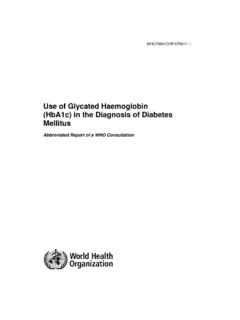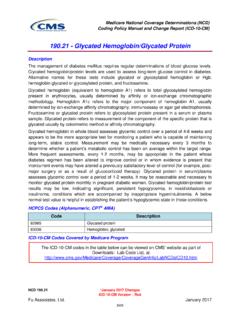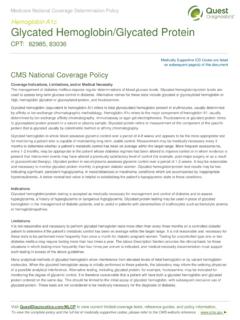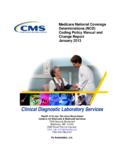Transcription of Glycated albumin: a potential biomarker in …
1 Copyright AE&M all rights Endocrinol Metab. 2017;61/3 Glycated albumin : a potential biomarker in diabetesPriscila Aparecida Correa Freitas1, Lethicia Rozales Ehlert , Jo za Lins Camargo1,2 ABSTRACTD iabetes mellitus (DM) is a chronic and metabolic disease that presents a high global incidence. Glycated hemoglobin (A1C) is the reference test for long-term glucose monitoring, and it exhibits an association with diabetic chronic complications. However, A1C is not recommended in clinical situations which may interfere with the metabolism of hemoglobin, such as in hemolytic, secondary or iron deficiency anemia, hemoglobinopathies, pregnancy, and uremia.
2 The Glycated albumin (GA) is a test that reflects short-term glycemia and is not influenced by situations that falsely alter A1C levels. GA is the higher Glycated portion of fructosamine. It is measured by a standardized enzymatic methodology, easy and fast to perform. These laboratory characteristics have ensured the highlight of GA in studies from the last decade, as a marker of monitoring and screening for DM, as well as a predictor of long-term outcomes of the disease. The aim of this review was to discuss the physiologi-cal and biochemistry characteristics of the GA, as well as its clinical utility in DM.
3 Arch Endocrinol Metab. 2017;61(3) mellitus; Glycated albumin ; Glycated proteins1 Programa de P s-gradua o em Ci ncias M dicas Endocrinologia, Universidade Federal do Rio Grande do Sul (UFRGS), Porto Alegre, RS, Brasil2 Servi o de Endocrinologia, Hospital de Cl nicas de Porto Alegre (HCPA), Porto Alegre, RS, BrasilCorrespondence to:Jo za Lins CamargoServi o de Endocrinologia,Hospital de Cl nicas de Porto AlegreRua Ramiro Barcellos, 2350Pr dio 12, CPE, 4 andar90035-903 Porto Alegre, RS, Received on Aug/2/2016 Accepted on Feb/13/2017 DOI: mellitus (DM) is a chronic metabolic disease caused by diminished or absent secretion of insulin or even by reduced tissue sensitivity to insulin (1,2).
4 Presently, DM is a worldwide epidemic and a great challenge to health care systems everywhere. The International diabetes Federation (IDF) estimates that one in eleven adults have DM, totalizing approximately 415 million people, and 193 million of them have not yet been diagnosed (1).Chronic hyperglycemia is a common feature in all subtypes of this disease and is associated with long-term damage, which increases the morbidity and mortality rates and causes dysfunction of different organs, such as kidney failure, blindness, and amputation of limbs (2). These chronic complications are costly to the health care systems and reduce the life expectancy of diabetic patients (1,2).
5 Currently, the laboratory tests used to diagnose DM are Glycated hemoglobin (A1C), fasting plasma glucose (FG) and two-hour plasma glucose (2hG) after a 75g oral glucose tolerance test (OGTT) (2,3). A1C is also the reference test for glycemic monitoring since it directly reflects mean glycemia (5) and is strongly correlated to the long-term complications of DM (4,5). However, the use of A1C is not recommended in some clinical situations that influence the hemoglobin metabolism (3,6,7), due to the possible interference in its results making them misinterpreted. Moreover, recent studies have shown a disagreement between the A1C levels in different ethnic groups for equal levels of glycemia (8,9), but the reasons for these disparities have not yet been well albumin (GA) is a laboratory test that has gained some importance for glycemic monitoring in DM in the last decades (10,11).
6 GA is one of the fructosamines, but it has the advantage of not being influenced by the concentration of other serum proteins since it is specific to the albumin glycation rates (12). Further, GA does not require fasting for its measurement and reflects short-term glycemia due to the half life time of the albumin , which is approximately 3 weeks. Compared to A1C, GA is not affected by the presence of hemolytic processes and abnormal Hb (13). Besides, in conditions such as anemia, pregnancy, postprandial hyperglycemia and DM using insulin, GA seems to be a better glycemic marker than A1C (11) and also it is especially indicated for diabetic patients on Copyright AE&M all rights albumin in diabetes mellitusArch Endocrinol Metab.
7 2017;61/3hemodialysis (14,15). Recently, studies on type 1 (16) and type 2 DM patients (17) reported an association of GA with the chronic complications of the GA is being studied in the last few years, this test is not yet widely used in laboratory routine, and few commercial reagents are available on the market to its analysis. However, the results of clinical investigations make GA a promising marker in DM. In this context, the proposal of this review is to present the physiological and laboratory characteristics of GA, and discuss its clinical usefulness in the diagnosis and management of CHARACTERISTICS OF GA AND BIOLOGICAL IMPACT OF GLYCATION albumin is a high molecular weight protein with kDa, composed of a single polypeptide chain which contains 585 amino acids, 17 disulfide bridges and 3 homologous domains that are connected in a helical structure (18).
8 It is the main plasma protein, representing about 60% of the total proteins in the blood, with concentrations between and g/dL and a half-life of 14 to 20 days (18,19). albumin structure makes it easier to perform its physiological functions, such as maintaining pH and blood osmotic pressure. Also, albumin acts as a powerful antioxidant and as the main transporter of metabolic products, ions, nutrients, drugs, hormones and fatty acids (20).Similar to the other proteins, albumin also goes through the physiologic process of glycation (21). By definition, glycation is a non-enzymatic spontaneous reaction in which a reducing sugar is added to a free amino group, typically lysine or arginine present within proteins, also called as Maillard reaction (Figure 1) (18-20).
9 The first step of this reaction involves the formation of an unstable and reversible product known as Schiff base, formed by the bonding of a carbonyl group of an acyclic carbohydrate with the N-terminal amino acid (19). This intermediate product can suffer a change in its conformation and result in a stable and irreversible ketamine, known as the Amadori product (22). The main Amadori adduct formed is fructoselysine, a reaction between glucose and lysine, which may occur on 59 lysine sites present in albumin (18). However, lysine 525 has been identified as the largest albumin glycation site, which is evidenced both in vivo and in vitro experiments (23,24).
10 The set of ketamines formed by non-enzymatic glycation of proteins is chemically called fructosamine . Among the serum fructosamines, GA is the main constituent, representing about 80% of the total of glycations in plasma (18).The glucose concentration and time of exposure between protein and sugar are the determining factors for the glycations performed during the life of the protein. In other words, glycation depends on the degree and duration of hyperglycemia (22). Extracellular proteins, such as albumin , may be more susceptible to Amadori rearrangements than intracellular proteins as Hb (18).













